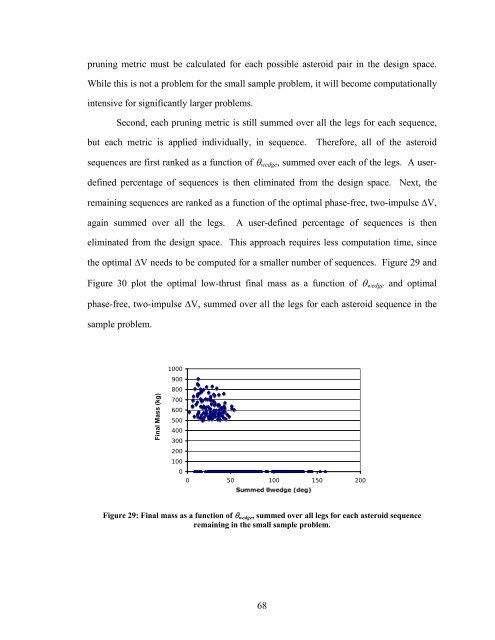design space pruning heuristics and global optimization method for ...
design space pruning heuristics and global optimization method for ...
design space pruning heuristics and global optimization method for ...
Create successful ePaper yourself
Turn your PDF publications into a flip-book with our unique Google optimized e-Paper software.
<strong>pruning</strong> metric must be calculated <strong>for</strong> each possible asteroid pair in the <strong>design</strong> <strong>space</strong>.<br />
While this is not a problem <strong>for</strong> the small sample problem, it will become computationally<br />
intensive <strong>for</strong> significantly larger problems.<br />
Second, each <strong>pruning</strong> metric is still summed over all the legs <strong>for</strong> each sequence,<br />
but each metric is applied individually, in sequence. There<strong>for</strong>e, all of the asteroid<br />
sequences are first ranked as a function of θ wedge , summed over each of the legs. A userdefined<br />
percentage of sequences is then eliminated from the <strong>design</strong> <strong>space</strong>. Next, the<br />
remaining sequences are ranked as a function of the optimal phase-free, two-impulse ∆V,<br />
again summed over all the legs. A user-defined percentage of sequences is then<br />
eliminated from the <strong>design</strong> <strong>space</strong>. This approach requires less computation time, since<br />
the optimal ∆V needs to be computed <strong>for</strong> a smaller number of sequences. Figure 29 <strong>and</strong><br />
Figure 30 plot the optimal low-thrust final mass as a function of θBwedgeB <strong>and</strong> optimal<br />
phase-free, two-impulse ∆V, summed over all the legs <strong>for</strong> each asteroid sequence in the<br />
sample problem.<br />
Final Mass (kg)<br />
1000<br />
900<br />
800<br />
700<br />
600<br />
500<br />
400<br />
300<br />
200<br />
100<br />
0<br />
0 50 100 150 200<br />
Figure 29: Final mass as a function of θ wedge , summed over all legs <strong>for</strong> each asteroid sequence<br />
remaining in the small sample problem.<br />
68
















